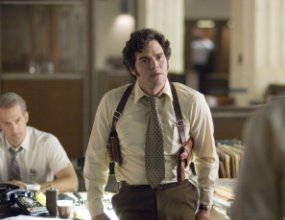 Life-eating obsession. Dizzying detail. Surgical precision. This two-disc Director’s Cut DVD slams home the point: this gripping true-life procedural is as much as about David Fincher’s hunt for the Zodiac killer as it is about the story of the men who burned up two decades of their lives looking for him.
Life-eating obsession. Dizzying detail. Surgical precision. This two-disc Director’s Cut DVD slams home the point: this gripping true-life procedural is as much as about David Fincher’s hunt for the Zodiac killer as it is about the story of the men who burned up two decades of their lives looking for him.
“I think the reason why the Zodiac still haunts us is the letters,” says Fincher on his intelligent, considered commentary. “The crimes themselves are, by today’s serial-killer standards, not that grotesque. But the letters are the key for me. This ongoing correspondence with someone who is ‘in process’, the evolution of his thinking.” The filmmaker might as well be talking about himself. Once again, he goes about meticulously, methodically recording his own process via another fantastic DVD package.
In Fincher’s hands, the tale of cartoonist Robert Graysmith (Jake Gyllenhaal), reporter Paul Avery (Robert Downey Jr) and detective Dave Toschi (Mark Ruffalo) hunting the San Francisco serial killer brilliantly fuses crime thriller, newspaper potboiler and period time-capsule. But Graysmith’s self-obliterating obsession is really Fincher’s target – piling up more and more facts, burrowing deeper into the labyrinthine mystery, chasing the truth until nothing else matters.
The devil in the detail. Fincher talks through decision to ditch the stylistic pyrotechnics of Fight Club and Panic Room (“I don’t want people to be distracted from anything the characters are saying”). His superhuman attention to the little things: camera, sound, editing, props, period intricacies (running 25 takes to get a three-second shot where someone compares two sets of handwriting). Forcing Gyllenhaal to carrying on shooting when he was sick with a 102 temperature (“I think it focused him – he’s truly great in that scene”).
Surprisingly, Fincher’s Director’s Cut adds just four minutes of extra footage. More dialogue. More of the process. “People just could not abide by a scene where three guys are talking into a speakerphone,” says the director, of one sequence in which the cops talk their boss through the case. “This scene cracks me up. Anytime you can cut to a speakerphone, it’s like Charlie. I just love the idea of these guys laying it all out for Charlie!”
Great banter and, yes, more process in a second commentary by Gyllenhaal, Downey Jr, producer Brad Fischer, screenwriter James Vanderbilt and particularly James Elloy. After introducing himself as “James Ellroy, king of American crime fiction, acknowledging this as one of the half-dozen great American crime films”, the author hurls out nuggets like, “You know there are systemic inequities in the death penalty system, but motherfuckers like this have to die.”
Split into The Film and The Facts, Disc Two unloads hours of featurettes dissecting everything you could possible want to know about the history of the Zodiac and the making of Fincher’s film. And probably plenty you didn’t. Case in point? Nearly three hours of interviews re-telling the story of the Zodiac case and prime suspect Arthur Leigh Allen.
It’s gasp-snatching stuff. Not only do we have vivid, deeply personal first-hand accounts from the policemen who worked on the Zodiac case, but survivors talking through in staggering detail horrific encounters with the Zodiac. Bryan Hartnell was stabbed six times and watched his girlfriend murdered. He coolly explains what he and the Zodiac said to each other (“Don’t worry, I just want your car”), what he was feeling (“I was taking a sociology class and I thought I might be able to squeeze a paper out of it”), what happened when the stabbing started and what he thinks of the scene in the film (“I couldn’t have scripted it better”).
Vanderbilt explains his own quest for the killer, researching the story through hours of interviews. “So you’re sitting having dinner with a very nice man and you know that at some point you’re gonna have to ask, ‘So… when you were tied up, how did you first know he was going to stab you?’” Then comes the eye-popping Making Of footage: Fincher pulling the strings on set and building his world, great and small (helicopters winch in giant trees, while production designers grovel in the mud planting individual weeds).
Copious FX featurettes also reveal the invisible magic behind Zodiac’s apparently ultra-realist drama. Ruffalo seems to spent much of his time wandering around a blue-screen set, while tech-experts fill in blood, knife blades, people walking their dogs on sidewalks and whole cityscapes.
Best of all in this fascinating insight into Fincher’s process? The director’s description of directing: “Imagine painting, but you’re 200 yards away from the canvas. And 80 people are holding the brush. And you’re a on walkie-talkie, going, ‘We need a little blue there. No, no, no, darker blue. DARKER BLUE!’”
FILM: [rating stars=”5″]
DISC: [rating stars=”5″]
Publication: Total Film.










